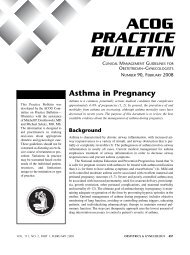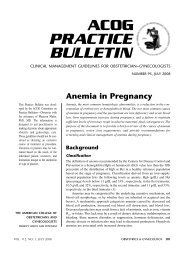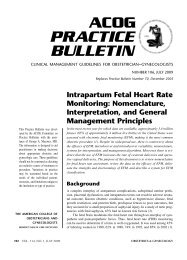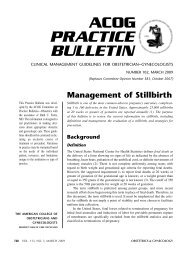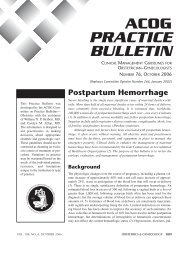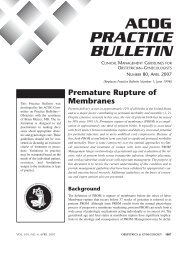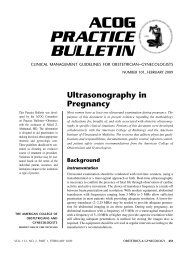ACOG Practice Bulletin
ACOG Practice Bulletin
ACOG Practice Bulletin
You also want an ePaper? Increase the reach of your titles
YUMPU automatically turns print PDFs into web optimized ePapers that Google loves.
ferent misoprostol protocols, yields inconsistent results<br />
to determine induction to delivery times, cesarean delivery<br />
rate, and risk of meconium passage (18, 21). The<br />
addition of oxytocin along with the use of the Foley<br />
catheter does not appear to shorten the time of delivery<br />
in a randomized controlled trial (39).<br />
Studies examining extraamniotic saline infused<br />
through the Foley catheter compared with use of the<br />
Foley catheter with concurrent oxytocin administration<br />
report conflicting results on the time from induction to<br />
delivery (19, 40, 41). Differences in methodology could<br />
explain the opposing findings. The Foley catheter is a<br />
reasonable and effective alternative for cervical ripening<br />
and inducing labor.<br />
Intracervical or intravaginal PGE 2<br />
(dinoprostone)<br />
commonly is used and is superior to placebo or no therapy<br />
in promoting cervical ripening (42). Several prospective<br />
randomized clinical trials and two meta-analyses have<br />
demonstrated that PGE 1<br />
(misoprostol) is an effective<br />
method for cervical ripening (43–48). Misoprostol administered<br />
intravaginally has been reported to be either superior<br />
to or as efficacious as dinoprostone gel (48–51).<br />
Vaginal misoprostol has been associated with less use of<br />
epidural analgesia, more vaginal deliveries within 24<br />
hours, and more uterine tachysystole with or without FHR<br />
changes compared with dinoprostone and oxytocin (48).<br />
In contrast, misoprostol compared with oxytocin for cervical<br />
ripening resulted in longer intervals to active labor<br />
and delivery in a randomized controlled trial (52). It is difficult,<br />
however, to compare the results of studies on misoprostol<br />
because of differences in endpoints, including<br />
Bishop score, duration of labor, total oxytocin use, successful<br />
induction, and cesarean delivery rate. Pharmacologic<br />
methods for cervical ripening do not decrease the<br />
likelihood of cesarean delivery.<br />
How should prostaglandins be administered?<br />
One quarter of an unscored 100-mcg tablet (ie, approximately<br />
25 mcg) of misoprostol should be considered as<br />
the initial dose for cervical ripening and labor induction.<br />
The frequency of administration should not be more than<br />
every 3–6 hours. In addition, oxytocin should not be<br />
administered less than 4 hours after the last misoprostol<br />
dose. Misoprostol in higher doses (50 mcg every 6<br />
hours) may be appropriate in some situations, although<br />
higher doses are associated with an increased risk of<br />
complications, including uterine tachysystole with FHR<br />
decelerations.<br />
If there is inadequate cervical change with minimal<br />
uterine activity after one dose of intracervical dinoprostone,<br />
a second dose may be given 6–12 hours later. The<br />
manufacturers recommend a maximum cumulative dose<br />
of 1.5 mg of dinoprostone (three doses or 7.5 mL of gel)<br />
within a 24-hour period. A minimum safe time interval<br />
between prostaglandin administration and initiation of<br />
oxytocin has not been determined. According to the<br />
manufacturers’ guidelines, after use of 1.5 mg of dinoprostone<br />
in the cervix or 2.5 mg in the vagina, oxytocin<br />
induction should be delayed for 6–12 hours because the<br />
effect of prostaglandins may be heightened with oxytocin.<br />
After use of dinoprostone in sustained-release<br />
form, delaying oxytocin induction for 30–60 minutes<br />
after removal is sufficient. Limited data are available on<br />
the use of buccal or sublingual misoprostol for cervical<br />
ripening or induction of labor, and these methods are not<br />
recommended for clinical use until further studies support<br />
their safety (53).<br />
What are the potential complications with<br />
each method of cervical ripening, and how<br />
are they managed?<br />
Tachysystole with or without FHR changes is more common<br />
with vaginal misoprostol compared with vaginal<br />
prostaglandin E 2<br />
, intracervical prostaglandin E 2<br />
, and oxytocin<br />
(48). Tachysystole (defined in some studies as greater<br />
than 5 uterine contractions in 10 minutes in consecutive<br />
10-minute intervals) and tachysystole with associated<br />
FHR decelerations are increased with a 50-mcg or greater<br />
dose of misoprostol (43, 47, 48, 54). There seems to be<br />
a trend toward lower rates of uterine tachysystole with<br />
FHR changes with lower dosages of misoprostol (25<br />
mcg every 6 hours versus every 3 hours) (48).<br />
The use of misoprostol in women with prior cesarean<br />
delivery or major uterine surgery has been associated<br />
with an increase in uterine rupture and, therefore, should<br />
be avoided in the third trimester (55, 56). An increase in<br />
meconium-stained amniotic fluid also has been reported<br />
with misoprostol use (47, 48). Although misoprostol appears<br />
to be safe and effective in inducing labor in women with<br />
unfavorable cervices, further studies are needed to determine<br />
the optimal route, dosage, timing interval, and pharmacokinetics<br />
of misoprostol. Moreover, data are needed on<br />
the management of complications related to misoprostol<br />
use and when it should be discontinued. If uterine tachysystole<br />
and a Category III FHR tracing (defined as either<br />
a sinusoidal pattern or an absent baseline FHR variability<br />
and any of the following: recurrent late decelerations, recurrent<br />
variable decelerations, or bradycardia) occurs with<br />
misoprostol use and there is no response to routine corrective<br />
measures (maternal repositioning and supplemental<br />
oxygen administration), cesarean delivery should be<br />
considered (32). Subcutaneous terbutaline also can be used<br />
in an attempt to correct the Category III FHR tracing or<br />
uterine tachysystole.<br />
390 <strong>ACOG</strong> <strong>Practice</strong> <strong>Bulletin</strong> Induction of Labor OBSTETRICS & GYNECOLOGY



